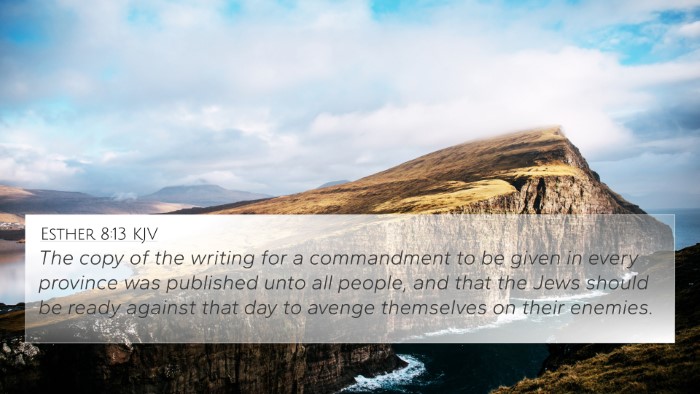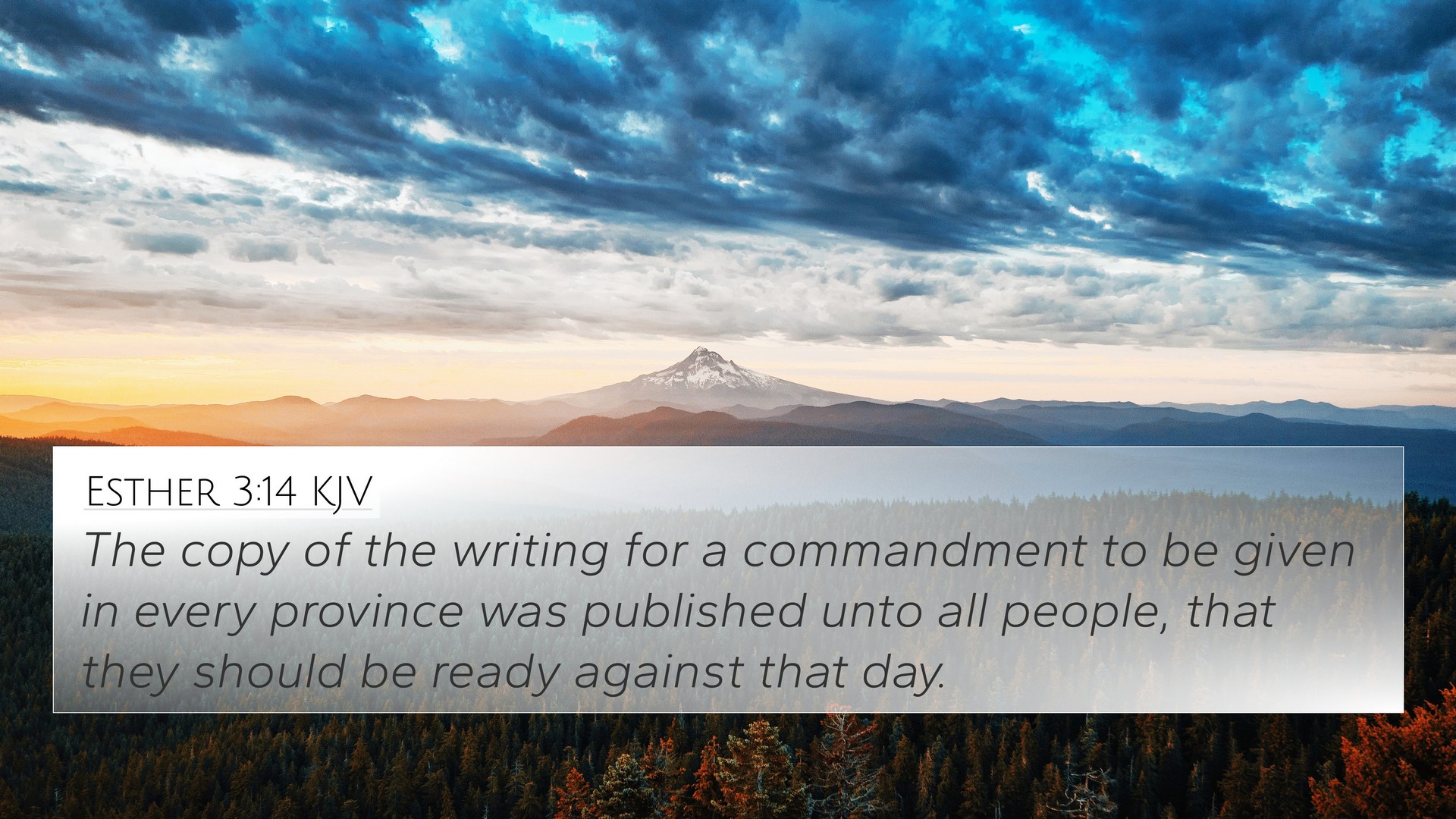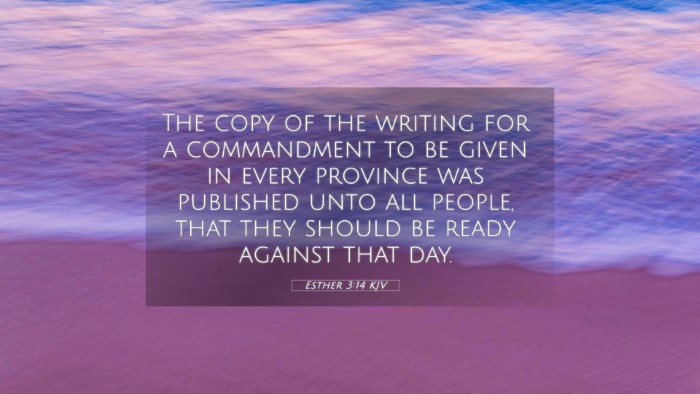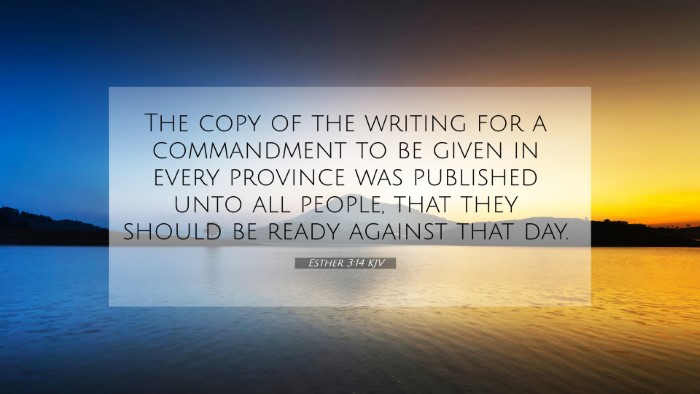Old Testament
Genesis Exodus Leviticus Numbers Deuteronomy Joshua Judges Ruth 1 Samuel 2 Samuel 1 Kings 2 Kings 1 Chronicles 2 Chronicles Ezra Nehemiah Esther Job Psalms Proverbs Ecclesiastes Song of Solomon Isaiah Jeremiah Lamentations Ezekiel Daniel Hosea Joel Amos Obadiah Jonah Micah Nahum Habakkuk Zephaniah Haggai Zechariah MalachiEsther 3:14 Similar Verses
Esther 3:14 Cross References
The copy of the writing for a commandment to be given in every province was published unto all people, that they should be ready against that day.
Uncover the Rich Themes and Topics of This Bible Verse
Listed below are the Bible themes associated with Esther 3:14. We invite you to explore each theme to gain deeper insights into the Scriptures.
Esther 3:14 Cross Reference Verses
This section features a detailed cross-reference designed to enrich your understanding of the Scriptures. Below, you will find carefully selected verses that echo the themes and teachings related to Esther 3:14 KJV. Click on any image to explore detailed analyses of related Bible verses and uncover deeper theological insights.

Esther 8:13 (KJV) »
The copy of the writing for a commandment to be given in every province was published unto all people, and that the Jews should be ready against that day to avenge themselves on their enemies.
Esther 3:14 Verse Analysis and Similar Verses
Understanding Esther 3:14
Esther 3:14 states: "The copy of the writing for a commandment to be given in every province was published unto all people, that they should be ready against that day." This verse reveals the gravity of a decree issued that had significant repercussions for the Jewish people in Persia.
Summary of the Verse's Meaning
This verse serves as a critical point in the Book of Esther, highlighting the pervasive influence of Haman's plot against the Jews. The publication of the royal edict would instigate a widespread response, illustrating how state decrees were disseminated and their potential to incite action among the populace.
Insights from Public Domain Commentaries
In exploring the meanings behind Esther 3:14, the commentaries of Matthew Henry, Albert Barnes, and Adam Clarke provide valuable perspectives:
- Matthew Henry: He emphasizes the foreboding nature of the decree and how it reflects the malice of Haman. The urgency in the command illustrates a calculated intent to destroy the Jewish people, prompting a community-wide alert.
- Albert Barnes: Barnes notes the logistical implications of the decree, stressing how the royal order required immediate compliance across vast territories, revealing the power of the king's edict and the dire consequences of refusal.
- Adam Clarke: Clarke offers a historical lens, explaining the bondage of the Jewish people under Persian rule. He interprets the proclamation as not only a threat to the Jews but as a demonstration of God's providence, foreshadowing their eventual deliverance.
Bible Cross-References
This verse can be cross-referenced with several other Biblical texts to enhance understanding:
- Esther 3:8-9: Discusses Haman's deceit and the instigation of the decree.
- Exodus 17:14: God's command to Moses about writing a memorial in a book, reflecting the importance of recorded decrees.
- Nehemiah 2:8: Reflects the authority of a king's letters and the journey of God's people in Babylon.
- Psalm 37:12-14: The wicked plotting against the righteous, paralleling Haman's plot against the Jews.
- Daniel 6:7-8: The decree against Daniel that illustrates the dangers of royal edicts.
- Matthew 2:16: Herod's decree to kill infants, another instance of a ruler's decree resulting in death.
- Acts 12:1-4: King Herod's actions that echo the threat against the early Christians.
- Revelation 12:17: The ongoing conflict between the people of God and their adversaries.
- Isaiah 54:17: Assurance that no weapon formed against God’s people shall prosper.
- Ephesians 6:12: The spiritual warfare pertained to all believers, resonating with the persecution faced by the Jews.
Connections and Interpretations
The cross-references above highlight the broader narrative of persecution and divine intervention found throughout scripture. Connections between Bible verses like those from Esther and New Testament events illuminate themes of bravery, faith, and vindication. This linkage emphasizes a consistent Biblical narrative where God's people face trials yet ultimately find redemption.
Thematic Bible Verse Connections
Esther 3:14 fits into larger themes throughout the Bible:
- Divine Providence: Just as God delivered the Jews in Esther, He is seen delivering His people throughout history.
- Courage under Persecution: The resolve shown by Esther and Mordecai mirrors the endurance required of believers under trials.
- The Power of Decrees: The impact of words from authority figures is a recurring motif seen with Pharaoh, Nebuchadnezzar, and others.
- Faithfulness to God: The Jewish response to the decree models a faith that trusts in God’s plans amid peril.
Conclusion
Esther 3:14 serves both as a narrative pivot and a profound lesson in faith and divine sovereignty. By engaging in comparative Bible verse analysis and exploring inter-Biblical dialogue, believers can glean invaluable insights into their faith, understanding that God works through circumstances to fulfill His promises.
Utilizing tools for Bible cross-referencing like concordances and cross-reference guides can further enrich one's study of scripture, illustrating how verses relate and enhance one another. The intricacies of how different Biblical passages interact speak to the depth of God's Word and the interconnectedness of His message across time and context.


